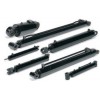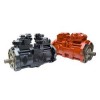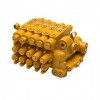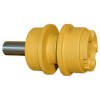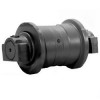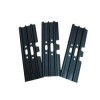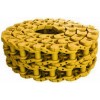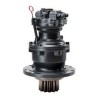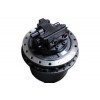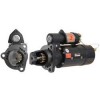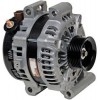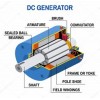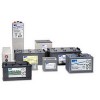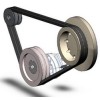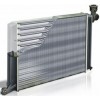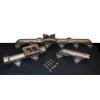Spare parts for heavy and construction Volvo equipments
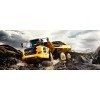
Buy spare parts for Volvo trucks and construction equipment in our online store and get high-quality spare parts at the best prices. We work with partners and distributors around the world and provides a wide range of spare parts Volvo at the lowest prices. Call or email us today for a free consultation on the original spare parts for Volvo technology and their duplicates.
The company Volvo Truck and Construction - a global manufacturer of construction machinery such as tractors, backhoe loaders, steam rollers, motor graders, wheel loaders, dumpers and equipment for harvesting. The company was founded Teofronom Myunktellem in 1832 in a machine shop in Eskilstuna, Sweden. Due to technical ingenuity Myunktellya, he was able to implement many exciting projects, such as Sweden's first locomotive, the first Swedish mechanical tissue machine, the first Swedish harvester and more. Teofron died in 1887.
When Myunktell retired from the Swedish Royal Mint and moved to Eskilstuna in its place came the brothers Jean and Carl Gerhard Bolinder, who in 1844 founded the company Kungsholmens Gjuteri & Maskin Verkstad in Stockholm. The brothers had their own production achievements, including the construction of the first Swedish internal combustion engine and to participate in designing the world's first military submarine. Karl Gerhard died in 1893, and Jean - in 1899.
100 years later, in 1932, the Great Depression in the United States led to the ruin of the company Krueger in Sweden. To keep the assets in the engineering industry, Handelsbanken Bank made merger and Myunktellya Boldinera and created AB Bolinder-Munktell. The company bought Volvo AB Bolinder-Munktell, and in 1995 after the purchase of shares by Volvo Clark Equipment manufacturer in VME Group Company was established Volvo Construction Equipment .
Volvo Hydraulic cylinder - volumetric hydraulic motor of reciprocating motion. The principle of operation of hydraulic cylinders is largely similar to the principle of the action of pneumatic cylinders. The moving part of the Volvo hydraulic cylinder, which may be a rod, a plunger or the cylinder body itself, performs reciprocating motion.
The main parameters that characterize all Volvo hydraulic cylinders are the internal diameter, stroke length, rod diameter and nominal working fluid pressure.
Volvo Hydraulic cylinders come in several types: piston, telescopic, plunger, two-sided and one-way. According to the type of attachment, Volvo hydraulic cylinders are divided into models with hinged fastening and rigid fastening.
Volvo single-acting hydraulic cylinder makes effort on the movable rod, which is directed only to one side (the working stroke of the cylinder). In the opposite direction, the movable link simply moves back under the action of gravity or a return mechanism, f →
The Volvo hydraulic system works as follows:
The diesel engine rotates the shaft of the Volvo hydraulic pump, which converts mechanical energy into energy hydraulic.
The hydraulic fluid is piped into the Volvo hydraulic pump and the Volvo hydraulic cylinders through the Volvo control valve system and converted there into mechanical energy of rotation or reciprocating motion.
After performing the work, the hydraulic fluid returns to the hydraulic oil tank and enters the Volvo hydraulic pump. The cycle of work is repeated.
Exist two types of heavy equipment Hydraulic systems:
A volumetric hydraulic system for its operation uses hydraulic motors and hydraulic pumps operating under high pressure up to 350 MPa. This system uses the principle of alternately filling the working chambers of the pump and the hydraulic motor with a hydraulic fluid and displacing it from there under high pressure. The speed of movement of the working fluid in such a system is small. The main factor →
When hydraulic systems are in operation, it becomes necessary to change the flow direction of the working fluid in its individual sections in order to change the direction of movement of the machine's actuators; it is required to provide the necessary sequence of activation of these mechanisms, to discharge the Volvo pump and the hydraulic system from pressure, and so on.
These and some other functions are performed by a special hydraulic device - the hydraulic Volvo control valve.
In the manufacture of Volvo hydraulic control valves, steel castings, modified cast iron, high and low carbon steel grades, and bronze are used as structural materials. To protect individual elements of the Cat control valves from abrasive wear, sliding surfaces are cemented, nitrided and so on.
The dimensions and mass of the Volvo control valve depend on the flow rate of the liquid through which the dimensions of the unit increase.
Thanks to the hydraulic system, the Volvo machine receives t →
The Volvo top roller is part of the moving part of the Volvo track. Its purpose is to ensure minimum sagging of the upper part of the Volvo track. Volvo top rollers are made of steel and are used to support the upper section of the track in the track chassis, which includes several supporting Volvo top rollers. They are located on the carrier, respectively, are installed on both sides, between the Volvo drive and return wheels. The Volvo top roller for supporting the tracks and chassis includes a bearing block with a roller. This mechanism, which has the ability to rotate, connects to the suspension unit suspension Volvo undercarriage.
The Volvo top roller (Volvo roller, Volvo upper roller) is a Volvo track element designed to support the upper part of the Volvo track and to facilitate tension that reduces sagging. The use of a lot support rollers reduces the force necessary for pulling the track. Also, Volvo rollers prevent Volvo strikes on the frame and give the track contour an o →
Volvo Bottom Roller is a crawler drive element that is a movable support for a Volvo equipment (a tractor, bulldozer, excavator, etc.) that use Volvo track chains. The part is to be installed with Volvo bearings on the axles to the suspension of the running gear.
Volvo bottom rollers are mounted on bearings on axles that are connected to the body through a suspension. In order to mitigate impacts on the Volvo during the movement in a rough terrain, the Volvo rollers are usually made rubberized. It can also be made of composite materials. Volvo bottom rollers have an internal design based on a coil or cylindrical roller bearings. Thick-walled outer ring allows to withstand high radial loads.
Types of Volvo Bottom Rollers:
- Rubberized;
- Not rubberized;
- Rollers with internal cushioning.
Volvo Bottom roller supports the following functions:
- Improvement of the rotating Volvo track chain;
- Reduction of noise generated between the Volvo track chains and the Volv →
Volvo track shoe - an integral part of the crawler chain Volvo construction machines on equipment such as excavators, lifting machines, bulldozers, tractors and more. Designed to reduce the specific pressure of the weight of the base machine on the surface, which ensures patency on weak soils. To work equipped with rubber Volvo tracks in urban areas, reducing noise and damage cover (asphalt, concrete and so on). For work in wetland conditions, arched track shoes are used.
The Volvo shoe track is one of the components of the Volvo track. Volvo shoes tracks are cast or forged units of wear-resistant steel, having on the outer surface of the lugs on the inner surface - the guide ridges, and apertures which include the teeth of the drive wheels, and lugs, which includes connecting pins pivotally connecting the tracks with each other. According to the constructive implementation of the Volvo links, there are composite and integral castings.
At present, several dozen types of Volvo sho →
The Volvo track chain is an important part of the Volvo track, it consists of movable elements that are connected together by means of fingers and bushings. It is this part that comes into contact with the ground surface during operation and exerts pressure on it. Using a crawler chain allows you to reduce pressure on the soil, which increases the throughput of Volvo Heavy Equipment.
The Volvo tracks consist of bushes into which the fingers are placed, so joints are formed, allowing the chains to fit tightly the guide and the driving wheel.
Like any other equipment, the Volvo equipment, over time, requires replacement of worn out Volvo parts. If you need to replace spare parts like Volvo track chains, you should pay attention to such moments: the length of the crawler chain and the diameter.
The Volvo track chain can be mounted on motor grader, tractor, bulldozer and excavator Volvo. Such products are characterized by a long operating term, as well as a high level of patency.
→
Rotation of the working equipment of equipment to the place of unloading the bucket and a reverse rotation to the place of dripping are carried out by turning the turntable or the whole platform (for full-cycle Volvo excavators). The rotation takes approximately 60-70% of the working cycle time and significantly affects its overall duration.
The hydrostatic Volvo Swing Motor just performs the function of turning in the horizontal plane of the working equipment relative to the running gear of the Volvo equipment.
The Swing Volvo Motor consists of a sturdy steel casing, in which several pairs of Novikov gearing gears are compactly arranged, allowing the transfer of loads significantly exceeding the permissible values for involuntary engagement. On the low-speed shaft, on the splines, the output gear is attached, which is included in the open gearing with a gear ring of the turntable of the Volvo Heavy Equipment.
A large cogwheel is mounted on the fixed part of the Volvo platfo →
The Volvo Travel Motor is a design made up of gears and other operating elements that are driven by a gear train.
The simplest Volvo Travel Motor consists of a carrier. It is designed to fix the satellites relative to each other so that they move together.
For proper operation of the Volvo Travel Motor, it is necessary that one of the constituent parts of it is rigidly fixed to the casing. In the Volvo Travel Motor, which is equipped with a carrier, the static part is exactly it. In addition, the crown or solar gear may be rigidly fixed. In the event that none of the parts of this unit is fixed, it is possible to separate one movement into several, or merge the two into one.
Due to this design, the drive and driven shafts of the Volvo moving in one direction.
Serves the Volvo Travel Motor to ensure a lower gear and at the same time increase the torque. To ensure the operation of this mechanism, the rotating shaft of the Volvo joins its driven element.
Lubrication of all →
The Volvo Final Drive is a design made up of gears and other operating elements that are driven by a gear train.
The simplest Volvo Final Drive consists of a carrier. It is designed to fix the satellites relative to each other so that they move together.
For proper operation of the Volvo Final Drive, it is necessary that one of the constituent parts of it is rigidly fixed to the casing. In the Volvo Final Drive, which is equipped with a carrier, the static part is exactly it. In addition, the crown or solar gear may be rigidly fixed. In the event that none of the parts of this unit is fixed, it is possible to separate one movement into several, or merge the two into one.
Due to this design, the drive and driven shafts of the Volvo moving in one direction.
Serves the Volvo Final Drive to ensure a lower gear and at the same time increase the torque. To ensure the operation of this mechanism, the rotating shaft of the Volvo joins its driven element.
Lubrication of all compo →
Volvo Sensors have a huge functional load. They are responsible for the serviceability and correct operation of the power unit, as well as provide convenience and performance of the work on the Volvo heavy equipment, as well as the safety of the operator of the equipment during direct movement or work.
Sensors and devices that perform diagnostics of all mechanisms, aggregates and systems of Volvo heavy equipment, are necessary for the timely warning of the operator of possible malfunctions.
Data from the Volvo sensors monitor the temperature, pressure, position of the parts, fluid levels, and the use of other equipment nodes or devices.
Each Volvo sensor is responsible for its indicator or parameter. The number of sensors in each, even the smallest Volvo machine, is extremely large. The variety of functionality of Volvo sensors is enormous, as is the importance of each of them in the performance of Volvo technology in general.
Only with us you will find and be able to buy o →
As the name suggests, a Volvo starter for heavy equipment is used to start an internal combustion engine. To do this, it provides a primary rotation of the crankshaft with the required frequency. The starter is an integral part of the electrical system of any modern Volvo equipment. Structurally it is a four-pole DC motor, powered by a Volvo battery.
The Volvo engine generates the energy necessary for the movement of the Volvo equipment, due to the speed of the Volvo crankshaft. All electrical equipment works from the same energy. In a stationary state, the engine is not capable of delivering either torque or electric energy. In this regard, it is necessary to "untwist" it with a special electric motor - a Volvo starter motor, and an external power source - a Volvo battery.
On motors with diesel power system, as well as on high-power engines, a Volvo starter motor with a gearbox is installed. The planetary gearbox, consisting of several gears, is mounted in the starter →
Electrical equipment of any Volvo equipment includes an alternator Volvo or AC Volvo generator - a device that converts the mechanical energy received from a Volvo engine into an electrical one. Together with a voltage regulator, it is called an alternator set. Volvo alternators are installed on modern Volvo equipment. They meet the requirements to the greatest degree.
Requirements for the Volvo alternator:
- the output parameters of the Volvo alternator must be such that in any mode of motion of the machinery there is no progressive discharge of the Volvo battery;
- The voltage in the onboard network of equipment powered by the Volvo alternator must be stable over a wide range of speed and load variations.
The latter requirement is caused by the fact that the Volvo rechargeable battery is very sensitive to the degree of voltage stability. Too low voltage causes a low battery and, as a consequence, difficulties with starting the engine, too high voltage leads to a battery r →
To convert various types of energy into electrical, special devices are used. One of the simplest mechanisms is the DC Volvo generator.
The DC Volvo generator is a device that converts mechanical energy into electrical energy for further use in an external circuit. The source of mechanical energy in this case can serve as any mechanical effort: the rotation of a special handle, the Volvo engine and so on.
There are such types of DC Volvo generators: self-excitation inclusion and working on the principle of independent inclusion. The methods of excitation depend on the type of power supply of the device. The self-excited Volvo generator works from external sources, it can be a rechargeable battery.
Unlike Volvo alternators (or AC Volvo generators), devices with a constant type of electricity need an uninterruptible power supply that constantly directs the DC current to the armature winding. Because of this, the field of application of such devices is quite narrowly specialized, →
Electric Volvo battery - a chemical source of current, a source of electro-driving force of reusable action. The main specificity is the reversibility of internal chemical processes. That provides its multiple cyclic use (through charge-discharge) for the accumulation of energy and autonomous power supply of various electrical devices and equipment, as well as to provide backup sources of energy in vehicles and Volvo heavy equipment.
The most common now are:
1. Lead Acid is the most common type of battery used in Volvo's heavy equipment, or as an uninterruptible power supply in emergencies.
2. Nickel-cadmium (NiCd) - the most widely used as a replacement for a standard galvanic cell, also used in Volvo electric forklifts and other Volvo electrical equipment.
3. Nickel-metal hydride (NiMH) - also used as a replacement for a standard galvanic cell, in electric vehicles.
Please note that Volvo acid batteries are not allowed for air travel. We sheep it by sea or by →
Belt transmission is the transmission of mechanical energy by means of a flexible element - the Volvo drive belt, due to frictional forces or engagement forces (Volvo timing belts). It can have both a constant and variable gear ratio, whose shafts can be with parallel and intersecting axes.
The Volvo belt performs two tasks: it operates a gas distribution system and aggregates of additional equipment such as a Volvo generator, a Volvo air conditioner compressor and so on.
There is a huge variety of drive belts:
- Volvo V-belt
- Toothed Volvo belt
Also distinguish single-row belts and multi-row Volvo belts. All of the above belts have one task - to drive the Volvo pulley of additional equipment or to drive other systems of equipment.
Volvo pulleys transmit torque using Volvo belts.
Original and replacement or aftermarket Volvo belts online.
RM13371695 Belt
VOE15171845 V-Ribbed Belt
RM13465554 Belt
VOE17284603 Belt
→
The plunger and piston Volvo water pump are widely distributed, as their work is effective at high final pressure.
The purpose of the Volvo water pump in the cooling system is to pump the cooling liquid through the cooling system. The main task is to force the coolant into the cooling Volvo radiator, as a result of the operation of the Volvo thermostat and the start of a large circle of engine cooling.
How does the Volvo piston water pump work?
The principle of operation of the Volvo piston water pump is to pump the liquid by suction. What does it mean? The piston creates a translational motion, through which the liquid enters the cavity of the lower part of the device from a special tube. When the piston does reverse movement, the valve on the pipeline closes and thereby prevents the fluid from flowing back. However, another valve opens on the discharge pipe. At the primary suction it was closed. These processes are repeated again and again, so that the fluid is constantly pu →
The cooling system plays a very important role, since it prevents the engine from overheating. The most important element of the cooling system is the Volvo radiator, which provides effective cooling of the liquid.
The cooling system performs the following functions:
- heat the air in the ventilation, heating and air conditioning system;
- cool the oil in the lubrication system;
- cool the exhaust gases in the exhaust gas recirculation system;
- cool the air in the turbo system.
Most of the modern technology is equipped with a water cooling system, among which the advantages are an effective uniform cooling. In addition, the water cooling system has a low noise level.
Cooling system design:
- Volvo radiator;
- Heater heat exchanger;
- Oil radiator;
- Expansion tank;
- Thermostat;
- Volvo water pump;
- Volvo radiator fan;
- Branch pipes;
- Controls.
The principle of the cooling system is as follows. Thanks to the liquid pump, the coolan →
Volvo turbocharger is a technically sophisticated mechanism that uses the kinetic energy of the exhaust gases to increase the pressure inside the Volvo intake system. Compressing, a mixture of fuel and air increases the mass of the fuel charge inside the Volvo cylinders, which increases the caloric content and, consequently, the engine power.
The essence of the Volvo turbocharger is the strongest compression of air that enters the engine and enriches the fuel mixture, creating a high explosion power in the cylinder - this greatly improves the mass ratio of the Volvo engine to its power. Based on this, it can be argued that an engine with a Volvo turbocharger produces much more useful energy than the same unit without it. The operating speed of the Volvo turbine can be about 250,000 - 280,000 rpm. For comparison, the speed of the internal combustion engine itself is 30 times less. And since the Volvo turbocharger works by exhaust gases, the operating temperature of the supercharger i →
Air or fuel / air mixture enters the cylinders through the Volvo Construction intake manifold. The main purpose of the intake manifold is to ensure an even distribution of air or working mixture between the cylinders. This directly affects the efficiency of the Volvo engine. In addition, other nodes can be attached to the manifold.
The principle of operation of the intake manifold of the Volvo engine is quite simple: air or its mixture with fuel, getting inside through the inlet, is divided into several streams, according to the number of cylinders of the engine. Pistons, moving downwards, create a vacuum in the collector, which can reach large values. This partial vacuum is also used to neutralize crankcase gases. They pass through the engine crankcase ventilation system into the Volvo intake manifold, mix with the fuel-air mixture or air and are burned in the cylinders.
Until recently, the main material for the manufacture of the Volvo intake manifold of was aluminum, iron and →
